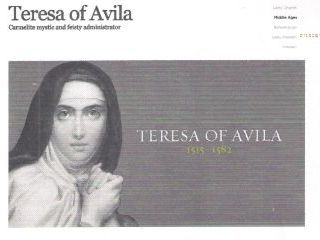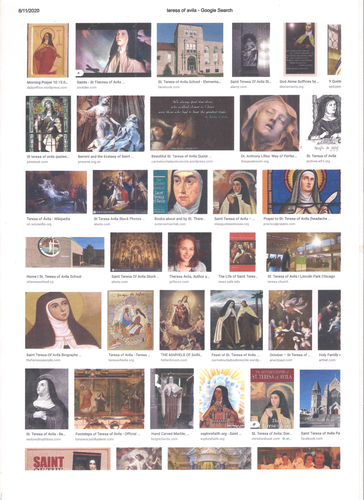
















Teresa at the age of 21, against her father’s wishes, professed her vows as a Carmelite at the Spanish Convent of the Incarnation at Avilla.
The relaxed rule of the Carmelites began to offend her. But 3 years suffering from a prolonged illness forced her to read books on the spiritual life. The ‘Letters’ of Jerome helped - his strong advocacy of the monastic life for women inspired her to begin again.
By 1540 she was ready to ready to resume convent life but she was partly paraiyzed. For 12 more years she struggled to achieve that perfect love of
In her autobiography* Life* she wrote ’ I voyaged on this tempestuous sea for almost 20 years with these fallings and risings’
Things began to changed when her glance fell on a statute of the wounded Christ.Jesus broke down her defences to reveal the reason for her spiritual exhaustion- her dalliance with the delights of sin.
She broke from her past and under went a final conversion (1555).She dreamed of establishing convents where young women could pursue deep lives of prayer and devotion. In 1559 she had the ‘transfixion’ - a cherub pierced her heart with an arrow leaving her with a burning love of God and an unquenchable desire for his presence.
This led her into reform. In 1563, with the blessing of Pope Paul 1V she opened the reformed Carmelite convent of St. Joseph in Avila. There the Discalced (shoeless) Carmelites would live under her new strict rules. Her reforms required utter withdrawal so the nuns could meditate on divine law and through a prayful life of penance, exercise what she termed ‘our vocation of reparation’ for the sins of humankind.
She convinced John of the Cross to join her in the work. Her success as an administrator and reformer resulted in her founding 16 monasteries.
Rest,indeed! I need no rest; what I need is crosses.
She died, exhausted, on 4th October 1582
Yet it is her gift of spiritual direction, practiced personally with nuns and publicly in her writings for which she is known today. She had to be persuaded to put pen to paper- the results were ’ Life’ her autobiography, ‘Way of Perfection’ - practical advice for her nuns, and ‘Interior Castle’ - a theological treatise.
Her legacy can be seen in Music, paintings, sculpture, literature , drama and film.
Her life and writings restored many of the religious institutions of Spain. The Spanish parliament named her the Patroness of Spain. In 1622 Pope Gregory XV proclaimed her a saint
Teresa of Avila was a major figure in the 16th century movement of Roman Catholic reform.
Differences between Discaled Carmelites and Carmelites
(See enclosed material for more information)
Sources used
Church History
Britannica Online Encyclopedia
wikipedia
Great Leaders of the Christian Church Woodbridge
contribution by Caroline T. Marshall
Something went wrong, please try again later.
This resource hasn't been reviewed yet
To ensure quality for our reviews, only customers who have downloaded this resource can review it
Report this resourceto let us know if it violates our terms and conditions.
Our customer service team will review your report and will be in touch.